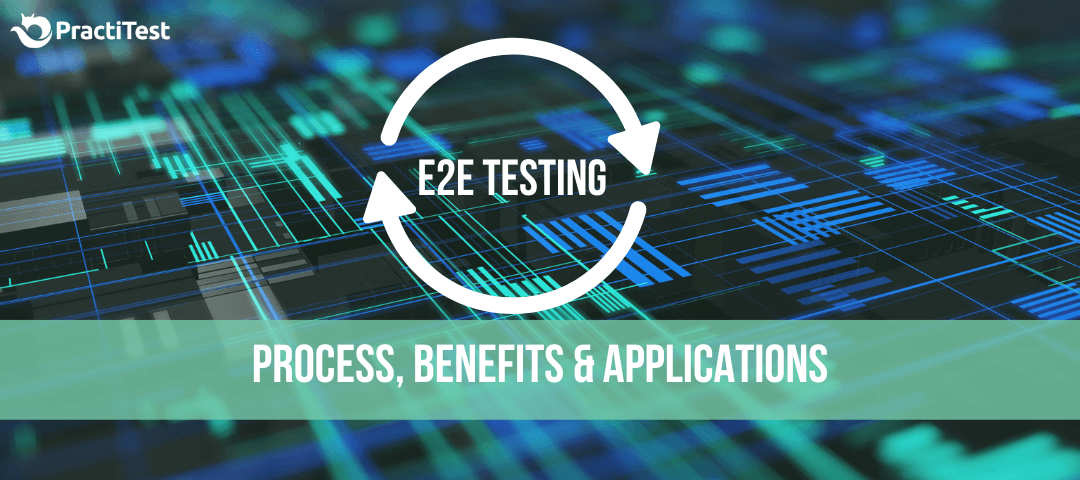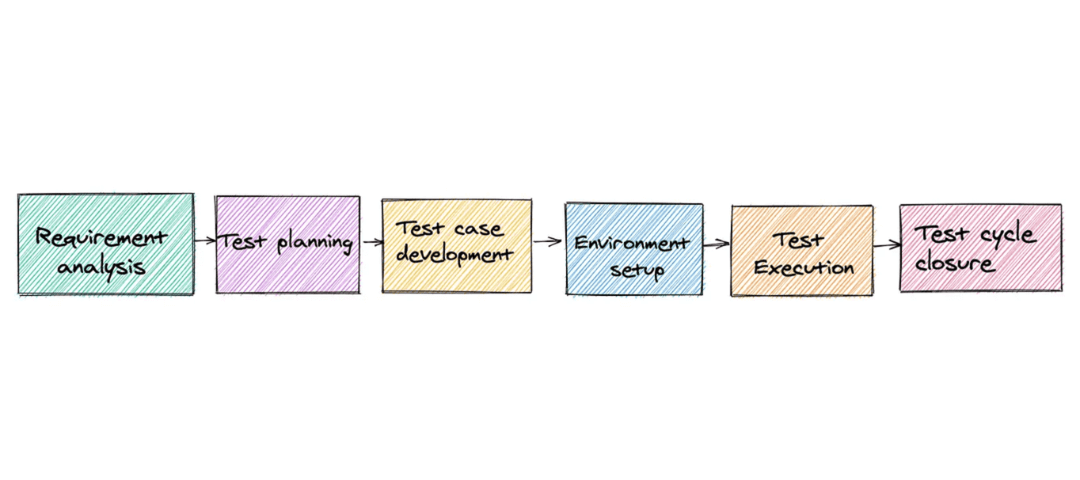End-To-End Testing: Process, Benefits & Applications
In This article
In the dynamic world of software development and engineering in general, ensuring that an application functions seamlessly from start to finish is prime. Enter end-to-end testing, a comprehensive approach that evaluates an entire software workflow, from user interactions to database interactions. In this blog, we will embark on a journey through the intricacies of end-to-end testing, exploring its significance, methodologies, best practices, and how it contributes to the delivery of robust and reliable software solutions.

Understanding End-to-End Testing
First of all let’s think about what is End-to-end testing? This process is often abbreviated as E2E testing, is a testing methodology that examines the complete workflow of a software application, ensuring that all integrated components function as intended. It simulates real-world scenarios, allowing testers to validate user interactions, data integrity, and system dependencies across various layers of the application.
Furthermore the scope of E2E testing goes beyond individual components and modules, encompassing the entire application stack. It verifies the interactions between different subsystems, databases, APIs, and external dependencies to validate the software’s behavior in a holistic environment.
The End-to-End Testing Process

All engineering teams and companies will have their own process in place, depending on their business skills, technical acumen and values of the company. However, it is important to have some sort of process for E2E testing in place, every company may not follow the exact process, but the following process can be used as a guideline.
Requirement Analysis: Understanding the project requirements is the foundational step. Testers collaborate with stakeholders to gain insights into the application’s functionalities, user scenarios, and business processes.
Test Planning: Based on the requirements, a comprehensive test plan is crafted. This plan outlines the testing approach, test scenarios, test data, and the overall strategy for executing end-to-end tests.
Environment Setup: Establishing a testing environment that mirrors the production environment is crucial. This includes configuring databases, setting up servers, and ensuring that all dependencies are in place to replicate real-world conditions. Unless this is done in the cloud, it would be good to understand how to set this up there too.
Test Case Design: Test scenarios are transformed into detailed test cases, covering various user journeys and system interactions. These test cases serve as a roadmap for the end-to-end testing process. Think about Heuristics and Mnemonics here if trying to work on automated tests like TRIMS ( Targeted, reliable, Informative, maintainable and speedy).
Test Execution: The actual testing process involves the systematic execution of test cases. Testers simulate user interactions with the application, observing how the software behaves under different conditions and validating the integrity of data flow.
Defect Identification and Reporting: Any discrepancies or defects discovered during test execution are meticulously documented. Testers provide detailed reports, including steps to reproduce issues and their impact on the overall system.
In all of this one major thing is communication, don’t forget to ask all ambiguities and assumptions. Testers usually think with a different mindset and have really good edge cases and thought processes. Therefore no question is classified as a ‘Silly’ question if it’s helping the teams think out of the box and save them from a production bug. Also E2E testing is something a testing team performs, but we should not forget that quality is a team responsibility.
Best Practices in End-to-End Testing
-
Realistic Test Scenarios: Design test scenarios that mimic real-world user interactions and business processes to uncover issues that might arise in actual usage.
-
Comprehensive Test Data: Ensure that test data represents a diverse set of scenarios, covering different user profiles, inputs, and edge cases.
-
Collaboration Across Teams: Foster collaboration between development, testing, and business teams to gain a holistic understanding of the application and its requirements.
-
Early Involvement in Development: Integrate end-to-end testing early in the development lifecycle to identify and address issues promptly, reducing the cost of fixing defects later.
-
Regular Maintenance of Test Cases: As the application evolves, regularly update and maintain test cases to align with changes in requirements and functionalities.
End-to-End Testing Vs. Integration Testing: What’s the Difference?
Integration Testing
Integration testing is a phase in the software testing life cycle where individual components or modules of a system are combined and tested as a group. The primary goal is to verify the interactions and interfaces between these components to ensure that they work together as intended. Integration testing helps identify issues such as data flow problems, interface mismatches, and communication errors between integrated components.
Key features of Integration Testing; Focuses on testing the interactions between integrated components, ensuring they can communicate and collaborate. Test Environment:
-
Environment: Typically conducted in a controlled environment, and stubs or drivers may be used to simulate the behavior of components that are not yet developed.
-
Objective: Validates that the components, when combined, produce the expected outcomes and function correctly as a group.
-
Isolation of Defects: Integration testing is designed to catch defects related to the interfaces and interactions between components, helping to isolate and address these issues early in the development process.
End-to-End Testing
End-to-end testing is a broader testing approach that evaluates the entire software application from start to finish, ensuring that all integrated components work together as a complete system. It involves testing the entire workflow or user journey to validate that the application behaves as expected in a real-world scenario. End-to-end testing goes beyond individual components and includes various subsystems, databases, external dependencies, and user interactions.
Key features of End-to-End Testing; Encompasses the entire application or a significant portion of it, testing the complete flow from the user’s perspective.
-
Test Environment: Conducted in an environment that closely resembles the production environment, providing a more realistic assessment of the software’s behavior.
-
Objective: Validates the overall functionality, performance, and reliability of the application by simulating real-world scenarios and user interactions.
-
Isolation of Defects: End-to-end testing is designed to catch defects related to the entire workflow, ensuring that the integrated components collaborate seamlessly to deliver the expected outcomes.
Key Differences
-
Scope Integration testing focuses on the interactions between integrated components. End-to-end testing evaluates the entire application from the user’s perspective, covering multiple components and subsystems.
-
Test Environment: Integration testing may use stubs or drivers to simulate components that are not yet developed. End-to-end testing is conducted in an environment that closely resembles the production environment.
-
Objective Integration testing validates the interactions between components. End-to-end testing validates the overall functionality, performance, and reliability of the entire application.
-
Isolation of Defects Integration testing isolates defects related to component interactions. End-to-end testing isolates defects related to the entire workflow and user interactions.
In summary, while integration testing focuses on the interactions between integrated components, end-to-end testing takes a broader approach, validating the entire application’s functionality and performance in real-world scenarios. Both testing approaches are crucial for ensuring the robustness and reliability of a software system.
End-to-End Testing Applications
End-to-end testing is applicable to a wide range of applications across various industries. Here are some examples of applications that benefit from end-to-end testing:
-
E-Commerce Platforms: E-commerce applications, including online marketplaces and retail platforms, rely on end-to-end testing to ensure smooth user journeys, secure transactions, and proper integration with payment gateways.
-
Banking and Financial Systems: Applications in the finance sector, such as banking systems and financial management platforms, undergo end-to-end testing to validate transaction processes, data accuracy, and compliance with security standards.
-
Healthcare Information Systems: Healthcare applications, including electronic health records (EHR) systems and telemedicine platforms, require end-to-end testing to verify data integrity, patient information security, and the seamless integration of medical devices.
-
Customer Relationship Management (CRM) Systems: CRM applications that manage customer interactions and data benefit from end-to-end testing to ensure that customer information is accurately processed, and communication channels function as expected.
-
Enterprise Resource Planning (ERP) Software: ERP systems, which integrate various business processes, undergo end-to-end testing to validate the flow of information across departments, data consistency, and the effectiveness of business workflows.
-
Supply Chain Management Systems: Applications in supply chain management, including inventory tracking and logistics platforms, are subject to end-to-end testing to confirm the accuracy of inventory data, order processing, and shipping functionalities.
-
Human Resources Management Systems (HRMS): HRMS applications undergo end-to-end testing to validate employee onboarding processes, payroll calculations, time and attendance tracking, and other HR-related workflows.
-
Educational Management Systems: Platforms used in education, such as learning management systems (LMS) and student information systems (SIS), are tested end-to-end to ensure the smooth delivery of educational content, enrollment processes, and grading functionalities.
-
Social Media Platforms: Social media applications require end-to-end testing to verify user interactions, content sharing features, real-time updates, and integration with external services.
-
Gaming Applications: Video games and gaming applications undergo end-to-end testing to ensure a seamless gaming experience, including graphics rendering, user interface responsiveness, and multiplayer functionalities.
-
Government Systems: Applications used in government sectors, such as tax filing systems, citizen portals, and public service platforms, are subjected to end-to-end testing to guarantee data security, regulatory compliance, and user accessibility.
-
Smart Home and Internet of Things (IoT) Applications: Applications that control smart home devices or IoT-enabled systems are tested end-to-end to ensure proper communication between devices, responsiveness, and data privacy.
-
Travel and Reservation Systems: Applications in the travel industry, including booking platforms, reservation systems, and travel management tools, undergo end-to-end testing to validate booking processes, payment integrations, and itinerary management.
-
Government Health Portals: Portals providing health-related services, vaccination scheduling, and public health information are subject to end-to-end testing to ensure accurate data dissemination and user-friendly interactions.
-
Event Management Platforms: Applications handling event planning and management, including ticketing systems and event registration platforms, undergo end-to-end testing to verify user registration, payment processing, and event logistics.
These examples illustrate the diverse range of applications that benefit from end-to-end testing to ensure functionality, user satisfaction, and overall system reliability. The specific testing requirements may vary based on the nature and complexity of each application.
Conclusion
End-to-end testing is the linchpin of a robust quality assurance strategy, ensuring that software applications meet user expectations and function seamlessly across diverse scenarios. By adopting a meticulous and comprehensive approach to testing, organizations can deliver software solutions that not only meet functional requirements but also provide a positive and reliable user experience. It is vital for many applications to go through E2E testing as seen on this blog to ensure all functionality works as intended reliably. As technology continues to advance, end-to-end testing remains an indispensable practice for achieving software excellence in the ever-evolving landscape of software development.
























